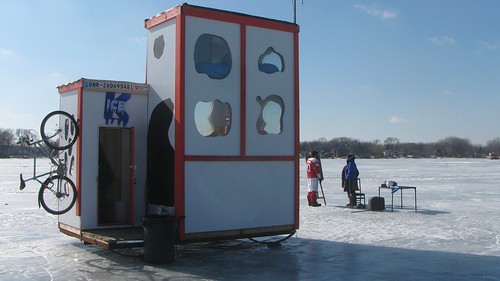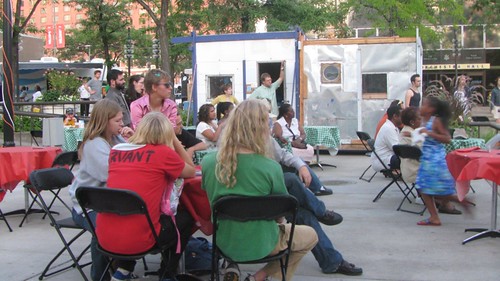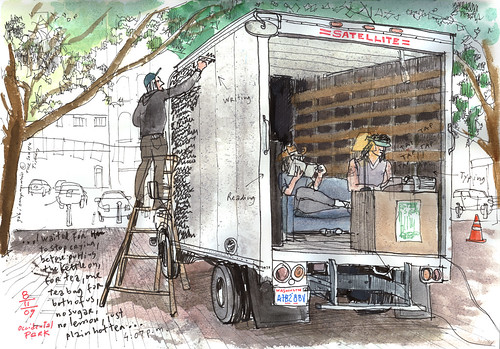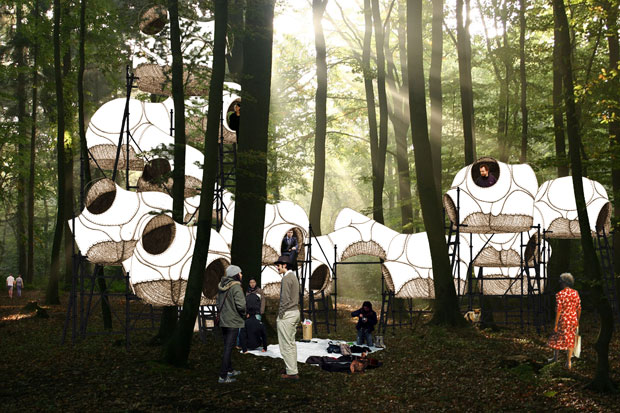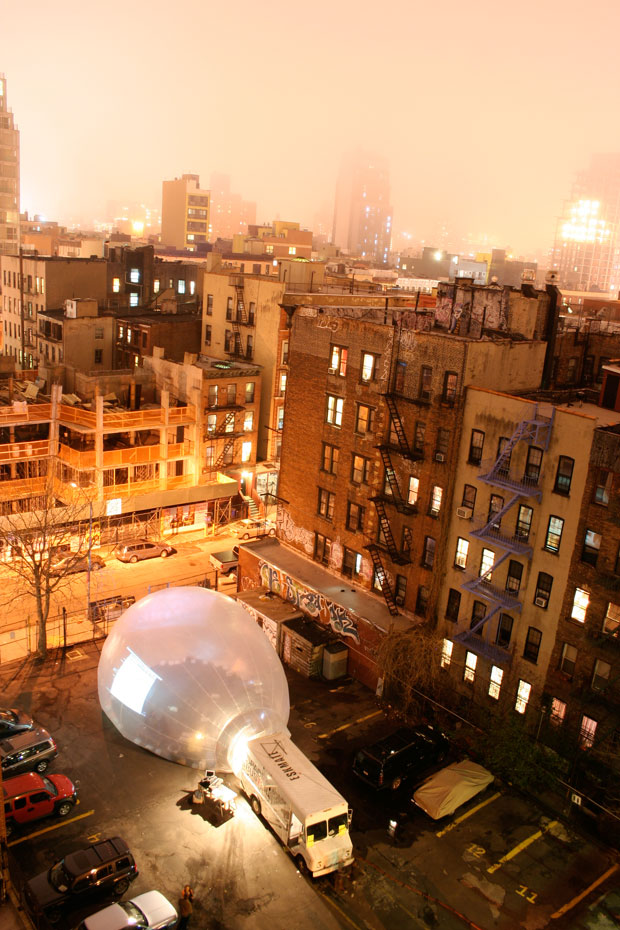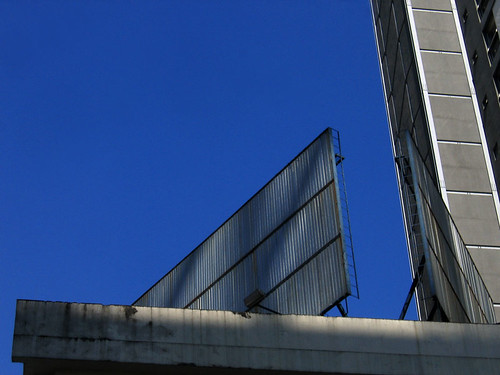
Rachel Hayes, Rainbow Conversation. Re:Construction Initiative
Open invitation for the Seventh Art Shanty Projects
Seeking visual artists, musicians, composers, media artists, architects, poets, scientists, dancer/choreographers, writers, builders, fisher-people, outdoors-people, naturalists, puppeteers, set designers, vocalists, spoken word artists, craftspeople, storytellers, actors, playwrights, etc. interested in participating in the design and construction of ice fishing shanty-like structures, producing engaging projects, art, events and shows on frozen Medicine Lake in Plymouth, MN during January and February 2010.
Application Deadline: October 5, 2009
See Art Shanty Projects 2010 Call for Proposals
Art Shanty, winter 2008
In 2008, Kulture Klub used one of the art shanties to participae in the UnConvention.
Stop (genocide)
Michael Zeng’s The Stop is an installation of 10 stop signs – at least from the front – at Charlson Park and Vanier Park, Vancouver, Canada, as part of the Vancouver Biennale 2009, which take place September 2009 – June 2011. Apparently, the “stop” view is from the sea wall looking into the park. When you walk around the backside, however, the signs become pink and remind me of a Google map pin marking a photo op with the harbor in the background.
It’s amusing. It would probably make me stop, make me look, maybe even listen. What more do you want in your public art?
It’s probably not a fair comparison, but even though I never saw it in person, I have a powerful mind image of Hachivi Edgar Heap of Bird’s signs along the Mississippi River commemorating the death by hanging of 40 Native Americans in 1862 and 1865 in Mankato, MN.
“As a sign of respect, forty Dakota-English, red lettered metal signs were exhibited originally in 1990 in the earth in the business zone of what was called the Grain Belt. This is a proud ‘historical’ districts of the city of Minneapolis and the state of Minnesota that houses the grain and flour mills, canals, and facilities to ship out the fruits of ‘American progress.'”
That would have made me stop, too, I think.
Listen to Clara Kim’s take on the project when she was a curatorial intern at the Walker Art Center.
Sketches of free sheep and a wild sheep chase
“Seattle Skethcer” is an illustrated journal of life in the Puget Sound region by Times artist Gabriel Campanario. In this story about “Public Art from the Back of a Truck,” he sketches the story of a 24-hour reading marathon of Haruki Murakami’s “A Wild Sheep Chase” from the back of a truck. According to Campanario, Holly Brown read the book out loud into a mike while Niko Rey transcribed the words on the side of the truck and another performance artist, D.K. Pan, typed on a $40 Olympia DeLuxe typewriter.
Rey and Pan are the founders of the Free Sheep Foundation,
“a non-profit organization whose mission is to foster site-specific projects through artistic interventions in architectural spaces. The foundation seeks partnerships with developers, architects, government agencies, and other arts organizations to identify and occupy buildings void of activity, opening these spaces to artists as facilities for cultural production; artist studios, exhibition and performance space. In transforming disused spaces, the foundation serves to integrate artists within the process of development. Through investigation and research, each project will contribute to the continuum of the past and future memories of a site.”
Red tape. And yellow and blue and green and white.
via Hrag Vartanian
“My street work consists mostly of isometric rectangles and squares. I selectively place these graphics around New York to highlight the unexpected contours and elegant geometry of the city itself. All execution of a piece is done on site with litle to no planning.”
“A new approach to urbanity”
Snuggles
raumlaborberlin has a solution for temporary festival housing.
“Snuggles was
designed by Berlin-based Raumlabor, which says that it is not an architecture firm, but rather an interdisciplinary team interested in urbanism, and the study of public and private space. The modular system was intended for use as comfortable, safe housing for travelers to festivals, workshops, or other artistic events. Each unit features a three-sided pod with a window and tunnel access to a central pod with sanitary facilities.”
via Inhabitat
According to their website, raumlaborberlin began working on the issues of contemporary architecture and urbanism in 1999m, and in various interdisciplinary working teams they investigate strategies for urban renewal.
Eichbaumoper
Eichbaumoper is Raumlabor’s vision for the transformation of the Eichbaum underground station between Mülheim and Essen where a new type of opera will be created in an on-site opera site office.
Spacebuster
Spacebuster opens urban space for temporary collective uses.
“The Spacebuster is build on the basis of a step van and a big inflatable space coming out of the back of the van fitting up to 80 persons in it. People enter the bubble through the passenger’s door of the van walking through to the back down a ramp right into the inflated space. The bubble is supported by air pressure generated by a fan underneath the ramp. The membrane of the bubble is translucent so people on the inside can see schematically what´s going on outside and vice versa. So the membrane acts as a semi permeable border between the public and the more private.”
Stick On City
Stick on city, an imaginary landscape through which visitors can take a tour, then add their own vision by drawing in and simply sticking it into the city, was presented at the 11th biennale of architecture, venice. In part it was a response to a visit to raumlabor by Archigramist Dennis Crompton, who talked about
“the scrapyard of visions, the city as responsive system, interactive buildings, good intentions, imaginary cities and the art of architecture that cannot fail.”
“A new approach to urbanity”
Snuggles
raumlaborberlin has a solution for temporary festival housing.
“Snuggles was
designed by Berlin-based Raumlabor, which says that it is not an architecture firm, but rather an interdisciplinary team interested in urbanism, and the study of public and private space. The modular system was intended for use as comfortable, safe housing for travelers to festivals, workshops, or other artistic events. Each unit features a three-sided pod with a window and tunnel access to a central pod with sanitary facilities.”
via Inhabitat
According to their website, raumlaborberlin began working on the issues of contemporary architecture and urbanism in 1999m, and in various interdisciplinary working teams they investigate strategies for urban renewal.
Eichbaumoper
Eichbaumoper is Raumlabor’s vision for the transformation of the Eichbaum underground station between Mülheim and Essen where a new type of opera will be created in an on-site opera site office.
Spacebuster
Spacebuster opens urban space for temporary collective uses.
“The Spacebuster is build on the basis of a step van and a big inflatable space coming out of the back of the van fitting up to 80 persons in it. People enter the bubble through the passenger’s door of the van walking through to the back down a ramp right into the inflated space. The bubble is supported by air pressure generated by a fan underneath the ramp. The membrane of the bubble is translucent so people on the inside can see schematically what´s going on outside and vice versa. So the membrane acts as a semi permeable border between the public and the more private.”
Stick On City
Stick on city, an imaginary landscape through which visitors can take a tour, then add their own vision by drawing in and simply sticking it into the city, was presented at the 11th biennale of architecture, venice. In part it was a response to a visit to raumlabor by Archigramist Dennis Crompton, who talked about
“the scrapyard of visions, the city as responsive system, interactive buildings, good intentions, imaginary cities and the art of architecture that cannot fail.”
Admission free, toga required
“Those About to Die Salute You, a battle on water wielded with baguette swords and watermelon cannon balls by New York’s art dignitaries, will take place on Thursday, August 13, 2009 at 6 pm in a flooded World’s Fair-era reflecting pool in Flushing Meadows Corona Park, just outside of the Queens Museum of Art. Various types of vessels have been designed and constructed by artist provocateur Duke Riley and his collaborators: the galleons, some made of reeds harvested in the park, will be used to stage a citywide battle of the art museums in which representatives from the Queens Museum of Art, the Brooklyn Museum, Bronx Museum of the Arts, and El Museo del Barrio will battle before a toga-clad crowd of frenzied onlookers.”
“For the Queens Museum, Mr. Riley proposed a naval battle reminiscent of naumachia, a type of bloody sea battle conducted in basins, lakes and amphitheaters to entertain Roman emperors like Caesar, Nero and later, Napoleon in Paris. More lavish than regular gladiator games, these boat battles were sometimes saved for moments when the restless or hungry masses needed placating, historians say. Mr. Riley says he appreciated the sentiment, as the world suffers through an economic downturn.
“The artist also found a parallel in the 1920s economic decadence of the “Great Gatsby†era when the park in Queens was a coal ash heap. He offered to build his boats using Phragmites australis, a wheat-like reed that is choking out the biodiversity of the park’s lakes and nearby wetlands because it can tolerate the ashy pollutants still seeping underneath.â€
via WSJ
Bollywood in Times Square
I want a flash mob.
via flavorwire
Making the city safe for pedestrians
Piéton Piéton from Piedlabiche on Vimeo.
Pied la biche is a collective that brings people together to make things about cities softness through interventions, science-fictions, films, lectures & texts.
Shop ‘n’ Mix
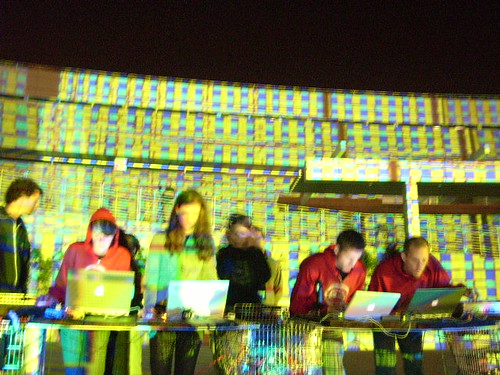
Matt Roberts and the Mobile Performance Group performed at the 1st 01SJ Biennial/ISEA2006 Symposium and made a great impression. Below is a clip from one of their latest roving public art projects, an interactive shopping cart. Very cool.
Location. Location. Location.
“Just after the opening of my solo show at Charlie James Gallery in Los Angeles we loaded up a rented pick-up truck with the arrow sign I included in the show. When I came across various locations in the city, we untied the sign, carried it over and snapped some shots – each time improvising a message for the face.”
via Steve Lambert
Still learning: the art of the drive by
I’m not sure today’s NYT article, In Los Angeles, Art That’s Worth a Detour is a trend or even particularly new, but it is a nice slide show. Isn’t the effect of the automobile on architecture and messaging one of the central themes of Venturi, Scott and Izenor’s 1977 Learning from Las Vegas? And Margaret Crane, Dale MacDonald, Scott Minneman, and Jon Winet’s 1997 Sunset Boulevard (pictured above) allowed drivers-by to advance a dual-screen narrative using their garage remotes. Electroland’s Hollywood Shadow Project used billboards silhouette of clasic movie scenes to cast shadows on nearby buildings approximately 90 minutes from sunset (get it?).
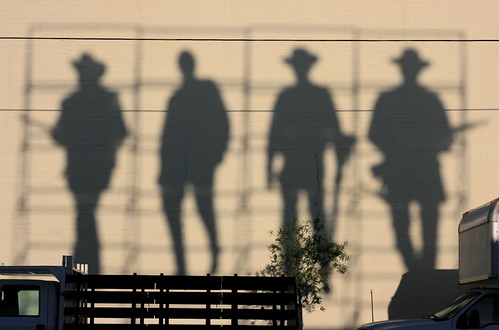
Photo by Alison Inconstanti
And, and, and. . . .
Your poetry written in stone

The 2009 Everyday Poems for City Sidewalk poetry contest is now open! Contest guidelines here. According to the Strib online:
“Following the success of last year’s inaugural ‘Everyday Poems for City Sidewalks’ project, the city and Public Art St. Paul once again are seeking poetry submissions from residents.
“People turned in more than 2,000 poems last year, and 20 winners were chosen. Their verses are sprinkled throughout the city’s nearly 1,000 miles of sidewalks.
“‘Our sidewalk poetry effort brings art to the outdoors where it can surprise, inspire, and make us laugh, smile, and think,’ said Mayor Chris Coleman.”
Everyday Poems for City Sidewalk is a project initiated by Marcus Young and friends, Saint Paul Public Works, and Public Art Saint Paul with Contributions from thirty-four Saint Paul Poets. Young is the City of Saint Paul Artist-in-Residence or “city artist.” Read his introduction to the project and the poems selected last year here.
Delete private public space
The mission of the Public Ad Campaign reads, in part:
Public Ad Campaign acts on the assumption that public space and the public’s interaction with that space is a vital component of our city’s health. By visually altering and physically interacting with the public environment, residents become psychologically invested in their community.
According to reporter Barbara Celis, the Public Ad Campaign recently found out that a number of NYC billboards are illegal, telling Celis:
“the agency that owns the ‘attacked’ billboards operates on an illegal basis. “NPA outdoor operates over 500 street level billboards in NYC ranging in size from about 4’x4′ to 50’x12′. All of these advertising structures are illegal. I found this out by talking to the NYC Department of Buildings which has no permits for the NPA outdoor structures but has its hands full dealing with the rampant illegal billboard situation. I have also spoken directly with NPA outdoor employees who have told me that the NYPD will jail them from time to time at which point NPA lawyers bail them out and they are compensated 500 dollars for the nuisance of spending the night in jail”.
On April 25, Public Ad Campaign organized the New York Street Advertising Takeover. Over 80 artists – and others “including an architect, a bio-physicist, a sports writer, a software developer, and countless others” – whitewashed 128 of the illegal signs and painted their own artful messages. Celis’s video is below and more information about the action is here and here, with lots of images on flickr.
They’re different but the NY Street Advertising Takeover reminds me of these remarkable photographs from Sao Paulo, when in 1997 city officials banned billboards, neon signs and electronic panels.
via Cool Hunting, Cronicasbarabas.com Public Ad Campaign, and Art Threat.

